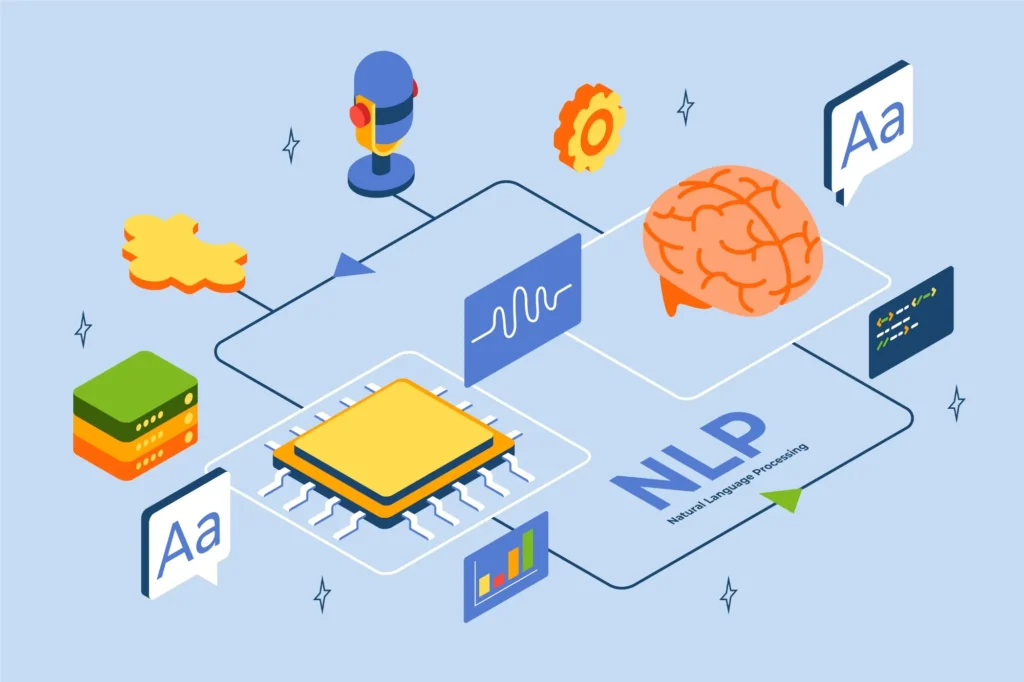Natural Language Processing (NLP) is a pivotal component of artificial intelligence, enabling computers to comprehend and process human language in its spoken and written forms. With roots in linguistics and over 50 years of development, NLP utilizes rule-based or machine-learning approaches to interpret text structure and meaning.
By preprocessing data to extract key features and developing algorithms, NLP facilitates various applications, from chatbots and voice assistants to translation tools and business intelligence systems. Its techniques, ranging from syntax and semantics analysis to text classification and machine translation, offer numerous benefits, including improved communication between humans and computers, automation of tasks, and deeper insights from vast volumes of textual data. Despite challenges such as precision, evolving language use, and bias, NLP continues to evolve, leveraging advancements in deep learning and computational power to become increasingly accurate, accessible, and indispensable across industries.
Table of Contents
Key Points
- Natural Language Processing (NLP) enables computers to understand and interpret human language, a crucial component of artificial intelligence (AI).
- NLP has roots in linguistics and has evolved over more than 50 years, finding applications across various fields like medical research, search engines, and business intelligence.
- Techniques in NLP include rule-based systems and machine-learning approaches, which help computers understand the structure and meaning of text.
- Data preprocessing is essential in NLP, involving tasks such as tokenization, stop word removal, lemmatization, and part-of-speech tagging.
- Syntax and semantic analysis are the main techniques used in NLP, including parsing, word segmentation, sentence breaking, and word sense disambiguation.
- NLP algorithms have real-world applications like text classification, text extraction, machine translation, and natural language generation.
- Tools like NLTK, Gensim, and NLP Architect are commonly used in NLP tasks, providing libraries and frameworks for developers.
- NLP benefits include improved communication between humans and computers, increased efficiency in documentation, and automation of various tasks like customer service and text summarization.
- Challenges in NLP include precision issues due to the ambiguity of natural language, difficulties in analyzing tone and inflection, evolving language usage, and the potential for bias in NLP systems.
- The evolution of NLP spans from rule-based systems to modern machine learning approaches, with ongoing advancements expected to make NLP more accurate, accessible, and relevant in various industries.
In the realm of technology, there exists a fascinating field known as Natural Language Processing (NLP), which empowers computers to comprehend and interpret human language. This transformative capability is an integral component of Artificial Intelligence (AI), enabling machines to engage with human speech and text in a manner akin to human understanding.
Understanding Natural Language Processing
Natural Language Processing, or NLP, has a rich history spanning over 50 years, rooted deeply in linguistic principles. At its core, NLP harnesses either rule-based or machine-learning methodologies to decipher the structure and meaning inherent in text. Its applications span across diverse domains, from medical research to business intelligence, from search engines to voice assistants.
The Mechanics of Natural Language Processing
NLP employs a myriad of techniques to equip computers with the ability to comprehend human language. From tokenization to part-of-speech tagging, from lemmatization to syntactic parsing, these methods serve to preprocess and structure textual data for subsequent analysis. Once the data is prepared, algorithms, ranging from rule-based systems to machine learning models, are employed to extract insights and derive meaning.
The Significance of Natural Language Processing
The significance of NLP lies in its capacity to unlock the vast troves of unstructured, text-heavy data that permeate the digital landscape. By enabling efficient processing and analysis of this data, NLP empowers businesses to derive actionable insights, enhance productivity, and streamline operations. From customer feedback analysis to automatic translation, from sentiment analysis to text extraction, NLP fuels a myriad of real-world applications.
Exploring Techniques and Methods
Syntax and semantics serve as the bedrock of NLP techniques. Syntax governs the arrangement of words in a sentence, facilitating grammatical analysis and parsing. Semantic analysis, on the other hand, delves into the meaning behind words, enabling algorithms to discern context and infer intent. Techniques such as word sense disambiguation and named entity recognition exemplify the semantic prowess of NLP.
Current Approaches and Tools
Contemporary approaches to NLP predominantly hinge upon deep learning methodologies, leveraging neural networks to discern patterns and correlations within data. Open-source tools like the Natural Language Toolkit (NLTK), Gensim, and NLP Architect by Intel empower developers and researchers to explore and implement NLP solutions across various domains.
Applications and Use Cases
The applications of NLP are as diverse as they are profound. From customer service automation to academic research analysis, from talent recruitment to plagiarism detection, NLP permeates numerous facets of modern life. Its ability to facilitate communication between humans and machines, automate tedious tasks, and derive actionable insights underscores its indispensability in today’s digital landscape.
Benefits and Challenges
The benefits of NLP are manifold, ranging from improved accuracy in documentation to enhanced customer support through chatbots. However, challenges such as precision in understanding nuanced language, adaptation to evolving linguistic trends, and mitigation of bias in algorithms underscore the ongoing complexities inherent in NLP development.
The Evolution of Natural Language Processing
From its nascent beginnings in the 1950s to its contemporary prominence, NLP has undergone a remarkable evolution. Transitioning from rule-based systems to data-driven approaches, NLP has witnessed advancements fueled by exponential growth in computing power and algorithmic sophistication. Its trajectory continues to be shaped by interdisciplinary collaboration and technological innovation.
Conclusion
In conclusion, Natural Language Processing stands at the forefront of technological innovation, bridging the gap between human language and machine intelligence. Despite its challenges, NLP remains poised to revolutionize industries, enhance user experiences, and redefine the boundaries of human-computer interaction. As we embark on this journey of exploration and discovery, the transformative potential of NLP is boundless.
Reference Links
Related Articles
- Understanding Information Technology (IT): The Backbone of Modern Business
- Understanding Algorithms: Definition, Functionality, and Real-life Applications
- Understanding Machine Learning: A Comprehensive Exploration
- Unlocking the Power of Machine Vision: Revolutionizing Industries
- Unlocking the Power of Expert Systems: Enhancing Decision-Making with AI
- Unlocking the Secrets of Artificial Intelligence
- Optimizing Logistics with AI: Revolutionizing Efficiency in Package Routing
Frequently Asks Questions
What is Natural Language Processing (NLP)?
NLP is a branch of artificial intelligence (AI) that focuses on enabling computers to understand, interpret, and generate human language in a way that is both spoken and written.
What are the main applications of NLP?
NLP has a wide range of applications including sentiment analysis, text classification, machine translation, chatbots, voice assistants, and information extraction from unstructured text data.
How does NLP enable computers to understand human language?
NLP utilizes various techniques such as tokenization, part-of-speech tagging, syntactic and semantic analysis, and machine learning algorithms to process and make sense of human language.
What are some examples of NLP preprocessing techniques?
Examples of NLP preprocessing techniques include tokenization, stop word removal, lemmatization, stemming, and part-of-speech tagging, which prepare text data for further analysis.
What are the two main types of NLP algorithms?
The two main types of NLP algorithms are rule-based systems, which rely on linguistic rules, and machine learning-based systems, which learn from training data to perform tasks.
What are the benefits of using NLP in business operations?
NLP helps businesses analyze and extract insights from large volumes of text data, improve customer service through chatbots and voice assistants, automate routine tasks, and gain competitive advantages through sentiment analysis and market research.
What are the challenges of NLP?
Challenges in NLP include handling ambiguity and evolving language use, ensuring precision in language processing, addressing biases in training data, and accurately interpreting tone and inflection in human speech.
How has NLP evolved?
NLP has evolved from rule-based systems to statistical approaches and, more recently, to deep learning techniques, leveraging advancements in computing power to achieve greater accuracy and efficiency.
What are some open-source tools commonly used for NLP?
Commonly used open-source tools for NLP include Natural Language Toolkit (NLTK), Gensim, and NLP Architect by Intel, which provide libraries and frameworks for developing NLP applications.
How does NLP contribute to academic research and analysis?
NLP enables researchers to analyze and extract insights from large volumes of academic material and research papers, facilitating literature reviews, data mining, and knowledge discovery.
What role does NLP play in customer feedback analysis?
NLP tools can analyze social media reviews and customer feedback to extract valuable insights, identify trends, and improve products and services based on customer sentiment.
How does NLP assist in healthcare record analysis?
NLP-based tools can analyze and categorize healthcare records, extract relevant information, and assist healthcare providers in clinical decision-making, disease prediction, and epidemiological research.
What is the significance of NLP in automatic translation?
NLP enables automatic translation of text between languages, facilitating communication and collaboration across linguistic barriers in various domains such as business, diplomacy, and academia.
How does NLP contribute to talent recruitment in human resources?
NLP-powered tools streamline the candidate sourcing and screening process, automate resume parsing, identify relevant skills and experiences, and enhance the efficiency of talent acquisition and management.
What are the ethical considerations in NLP?
Ethical considerations in NLP include ensuring fairness and transparency in algorithmic decision-making, mitigating biases in training data, protecting user privacy, and promoting responsible use of NLP technologies.
How does NLP address the challenges of spam detection?
NLP-based tools can analyze text for linguistic patterns commonly associated with spam or phishing attempts, helping to identify and filter out unsolicited or malicious content from emails, messages, and online platforms.
What are the future trends in NLP?
Future trends in NLP include advancements in deep learning models, enhanced multilingual capabilities, improved understanding of context and semantics, integration with multimodal data sources, and increased emphasis on ethical AI practices.
How can businesses leverage NLP for competitive advantage?
Businesses can leverage NLP for competitive advantage by harnessing insights from text data to improve customer experience, optimize operations, develop innovative products and services, and gain market intelligence.
What are some real-world examples of NLP applications?
Real-world examples of NLP applications include virtual assistants like Siri and Alexa, language translation services like Google Translate, sentiment analysis tools for social media monitoring, and content generation platforms based on language models like GPT-3.
How can individuals learn NLP skills and techniques?
Individuals can learn NLP skills and techniques through online courses, tutorials, books, and workshops offered by educational institutions, industry experts, and online platforms such as Coursera, Udemy, and Kaggle.


